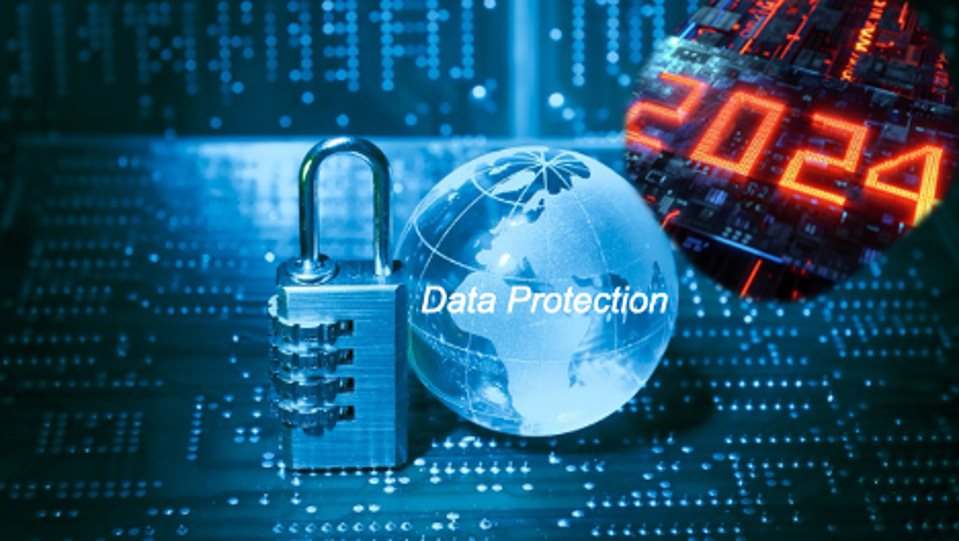
In 2024, data protection software stayed front and center for enterprises as cyber threats became more advanced and regulations more demanding. AI-powered tools came to the fore as a practical way to automate governance, maintain compliance and identify threats. Vendors such as Cohesity, Commvault, Rubrik and Veeam improved their market presence through a variety of means including acquisitions, partnerships, going public and adding features to their platforms. The new features included immutable backups and AI-driven anomaly detection, giving enterprises faster and more reliable ways to spot disruptions and recover from them. Observability tools also became increasingly relevant, bridging the gap between system monitoring and data protection to provide more integrated and proactive solutions.
2024 Data Protection: Key Vendor Highlights
One of the biggest shifts came when Cohesity completed its $7 billion acquisition of (a significant part of) Veritas in December, merging operations with a promise to deliver comprehensive data management and protection solutions. Key offerings aim to improve threat detection, simplify compliance and reduce the inefficiencies and blind spots caused by data silos. Summarizing the logic behind the deal, Cohesity CEO Sanjay Poonen stated, “This deal combines Cohesity’s speed and innovation with Veritas’ global presence and installed base.” The merged organization, projected to generate $2 billion in fiscal 2025 revenue, will serve over 13,000 customers, including many Fortune 100 and Global 500 companies. For more details, see the research paper that I wrote on Cohesity and the merger a few months ago.
Commvault introduced its Cloud Rewind feature, leveraging technology from its acquisition of Appranix to automate cloud application recovery. This feature automates the rebuilding of cloud applications after cyberattacks, including ransomware attacks, to help enterprises recover faster without relying on time-intensive manual processes. Sanjay Mirchandani, Commvault’s president and CEO, stated, “We are taking resilience to the next level by combining Commvault’s extensive risk, readiness and recovery capabilities with Appranix’s next-generation cloud-native rebuild capabilities.” By addressing data recovery and the restoration of cloud apps that interact with that data, Cloud Rewind aims to help enterprises minimize downtime and resume operations quickly; according to the company, it can often achieve this in a fraction of the time traditional methods require. Additionally, Commvault used its fourth-quarter Shift event in London to introduce new solutions for data recovery and cyber resilience designed to integrate with AWS, Google Cloud and other environments.
In April, Rubrik raised $752 million in an IPO to support the growth of its Zero Trust Data Security solutions for multi-cloud data protection. Building on its partnerships with Microsoft and AWS, the company introduced tools such as Cloud Vault for air-gapped backups on AWS and Azure Blob Protection for compressed immutable backups across Azure storage tiers. It also integrated AI-driven technologies to address various governance, compliance and threat mitigation challenges. Key innovations include Ruby, an AI assistant using the Azure OpenAI Service for cyber threat response; Data Threat Engine, which applies machine learning to detect suspicious activities; and SentryAI, an in-house engine analyzing customer telemetry data. These tools, combined with features like immutable backups and anomaly detection, aim to protect against threats such as ransomware and support faster recovery.
In December 2024, Veeam Software announced a $2 billion secondary equity offering led by TPG, with participation from Temasek, Neuberger Berman Capital Solutions and others; the financing values the company at $15 billion. (The transaction is set to close in early 2025, subject to regulatory approvals.) As of September 2024, Veeam reported $1.7 billion in ARR for its software and SaaS subscription business. CEO Anand Eswaran explained that the funding was intended to diversify the company’s investor base and prepare for strategic opportunities, including a potential IPO.
Cloud Service Providers And Other Data Protection Vendors
Beyond the data protection providers already mentioned, there are a range of larger and smaller vendors offering solutions to meet their customers’ data protection needs. In 2024, the three largest cloud providers—Microsoft, AWS, and Google Cloud—prioritized advancements in integrated data protection tools to address the growing challenges of AI adoption and cybersecurity threats. Microsoft announced the general availability of its Purview Data Governance solution. It included new features such as an embedded Copilot experience for data governance and enhanced integration with Microsoft Fabric. AWS improved its Amazon Macie service by developing a proof-of-concept for automated discovery, allowing customers to validate its effectiveness in strengthening data protection strategies. And at its 2024 Cloud Security Summit, Google Cloud introduced Mandiant Custom Threat Hunt for targeted threat detection, plus upgraded its Security Command Center to identify complex vulnerability combinations.
Smaller data protection providers also made strides in 2024 by introducing innovative solutions. Barracuda focused on enhancing storage efficiency and recovery times through advanced deduplication. Quest Software expanded its suite of tools to encompass backup, disaster recovery, ransomware prevention and data management. N2WS enabled cross-cloud volume restores between AWS and Azure, allowing for rapid data recovery across different platforms. HYCU improved its offerings for Nutanix environments, adding database protection, enhanced remote office support and improved security measures. Plus, HYCU partnered with Anthropic to enhance AI workload protection. Acronis improved its cybersecurity offerings with its Extended Detection and Response solution (called XDR) and enhanced network visibility. Carbonite focused on cloud backup improvements, adding features to protect against ransomware and refine disaster recovery capabilities. These advancements demonstrate the industry’s broad commitment to addressing the challenges of multi-cloud environments and evolving cybersecurity threats.
Observability Makes Its Mark
The observability market also continued to evolve in 2024, largely due to the growing complexity of IT environments, the shift to cloud and microservices architectures and the need for more efficient IT operations. The market is estimated to grow from $2.4 billion in 2023 to $4.1 billion by 2028, reflecting steady growth and the importance of observability for effective IT management.
Cisco’s acquisition of Splunk in March for about $28 billion brought notable changes for both companies. Cisco combined Splunk’s log management and analytics tools with its own network monitoring and security solutions. This integration made it easier to provide a more complete view of IT systems, covering everything from applications to networks. It also improved collaboration between security and IT operations teams, helping organizations address issues more quickly and efficiently. Key updates included Splunk Log Observer Connect for Cisco AppDynamics and the integration of Cisco AppDynamics with Splunk IT Service Intelligence. For Splunk, the acquisition meant access to Cisco’s resources and broader customer base, helping its tools reach more users.
Other important observability vendors, including Datadog, Dynatrace, New Relic, AppDynamics, LogicMonitor, SolarWinds, Sumo Logic and Elastic, likewise enhanced their platforms in 2024. In general they focused on improving real-time system monitoring with precise metrics and automated alerts, enabling faster and more effective responses to performance issues. Distributed tracing became a key area, helping engineers understand the complexities of microservices and identify bottlenecks. Log analysis remained critical, with vendors incorporating AI-powered analysis and advanced search to improve log management. Open-source solutions also played a significant role, with Prometheus standing out as a scalable time-series database and Grafana providing highly customizable dashboards that can visualize data from various sources. The rise of OpenTelemetry, an open-source standard for instrumenting applications and collecting telemetry data, is also influencing the future of observability. Across the industry, vendors such as LogicMonitor are increasingly leveraging AI and machine learning to automate tasks such as anomaly detection and root cause analysis.
IBM also made progress in observability during the year, building on its AI-driven features to provide more efficient monitoring and problem-solving capabilities with Cloud Logs and Concert. Concert, a generative AI-powered tool, offers insights across enterprise application portfolios, while Cloud Logs provides efficient log data collection and analysis. Across the industry, there was a clear focus on improving tools that handle application performance monitoring, real user monitoring, infrastructure monitoring and log management. Many of these platforms added or expanded AI and machine learning features to help IT teams analyze data faster and address anomalies before they become major issues.
In November 2024, LogicMonitor received an $800 million investment from a group including PSG and Golub Capital, valuing the company at $2.4 billion. LogicMonitor provides an agentless monitoring platform for data centers, covering infrastructure including networks, servers, virtual machines and cloud services (AWS, GCP, Azure). Under CEO Christina Kosmowski, the company is enhancing its AI-driven tools for IT management, system performance and cost efficiency while targeting new industries for a broader customer base. LogicMonitor plans to use the recent influx of capital to support platform growth, strategic acquisitions and global expansion.
What’s Next In 2025: AI, Predictive Analytics And Unified Platforms
In 2025, the data protection landscape is expected to continue evolving, with a stronger emphasis on integrating observability systems with data protection platforms. This integration, supported by advanced AI and predictive analytics, will shift the focus from threat detection to proactive risk mitigation and the automation of compliance processes, including managing user consents and handling data subject access requests. Automation tools are also likely to improve their compatibility with data protection systems, allowing organizations to address risks preemptively and enhance overall resilience.
Privacy-enhancing technologies are also anticipated to see advancements, particularly in fully homomorphic encryption, which could transform how sensitive data is processed securely. These developments stand to be especially impactful in sectors such as finance and healthcare, where data security is so critical. Additionally, regulatory changes are likely play a key role, particularly around AI governance and data sovereignty. Organizations will need to adapt to stricter compliance requirements, especially in relation to AI systems and cross-border data transfers, and develop more transparent data governance frameworks to address these evolving challenges.
The integration of Cohesity and Veritas will likely deliver new capabilities in real-time recovery and proactive threat detection, potentially reshaping industry expectations and putting pressure on the combined company’s competitors. Enhanced AI-driven data classification tools should help enterprises prioritize protection for their most sensitive information while maintaining regulatory compliance. Vendors such as Microsoft and Amazon are also expected to advance their capabilities, offering deeper insights into data usage and potential security gaps.
More broadly, it’s likely that AI-powered simulations and threat modeling will get even better at enabling enterprises to refine their defenses against emerging risks. By combining these capabilities with the observability tools mentioned, enterprises should be able to optimize operational continuity, reduce recovery times and navigate increasingly complex digital environments.
Better Data Protection And Observability For A More Complex IT Landscape
Data protection and observability have come a long way in 2024, taking advantage of the meteoric rise in AI capabilities to address long-running trends of more pervasive cyber threats, stricter regulations and increasingly complex IT systems. Enterprises are turning to a mix of new tools and strategies to protect their data and keep systems running smoothly. Vendors are rolling out AI-powered features, automation and integrated platforms to handle everything from cloud-native setups to multi-cloud and on-premises environments. These advancements make it easier for enterprises to handle disruptions, stay operational and build trust in a world that relies heavily on data.
Blending data protection and observability tools signals a shift toward smarter, faster strategies that keep up with real-time operational demands. This evolution should help enterprises stay resilient, adapt to challenges and maintain continuity in today’s unpredictable digital landscape.























































































